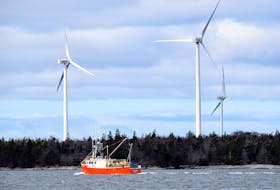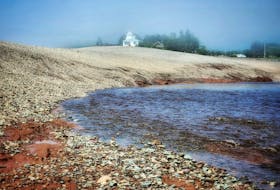Local author and journalist Joan Baxter is continuing her fight against Northern Pulp’s proposed mill waste pipe at an open house in Pictou Saturday, hosted by the Northumberland Fisheries Museum.
Baxter, whose book The Mill: 50 years of Pulp, Paper and Protest has chronicled decades of protest against the mill, is joining others concerned about Northern Pulp’s plan to discharge treated waste into the Northumberland Strait through dispersal pipes.
Northern Pulp says a new facility must be installed by 2020, to replace the Boat Harbour lagoon, that will properly treat effluent and minimize the impact on the environment and fishing areas, but Baxter remains unconvinced.
She also had questions for the province, which is responsible for cleaning up the Boat Harbour site.
“They should tell the people of NS who is going to have to pay how much for the clean-up of Boat Harbour – the province already estimates $133 million but it is likely to be higher – the new effluent treatment facility and any modifications that have to be made at the mill,” said Baxter in a Facebook message Friday.
She added that fishermen have expressed their concerns about the impact of treated waste on their livelihoods, even though Northern Pulp says their proposed pipe will use a six-port diffuser to properly disperse the effluent. There is no such diffuser in the present outflow.
But Baxter said that successive governments were too cozy with big business while not doing their job protecting the environment, as outlined in her book.
“I do think it tapped into what is a very long-standing disappointment with provincial governments of all stripes that seem to cozy up to big industries and that many people have told me have not done their job of protecting people and the environment,” said Baxter.
Northern Pulp spokesperson Kathy Cloutier said in an email Friday that effluent has been flowing into the Northumberland Strait for 50 years through the current off-site facility.
Their proposed pipe will be on-site, meaning that untreated effluent will no longer be transported in a pipeline leaving the mill after the new system is operational.
“Technical options available must include an outfall discharge in order for Northern Pulp to operate. The bottom line is no pipe equals no mill,” said Cloutier.
She added that there are 131 Kraft mills operating in North America of which 20 per cent use Northern Pulp’s present waste disposal system and 80 per cent operate the new system proposed by Northern Pulp in Pictou.
In both Canada and the United States, no other treatment process is used to treat kraft mill effluent. Northern Pulp has thoroughly investigated treatment options available to bleached kraft mills, where wood pulp is bleached as part of the manufacturing process.
Cloutier said Northern Pulp is also rolling out a $70-million project to cut the need for bleaching chemicals by 30 to 40 per cent when whitening wood pulp as it progresses through the system. This process is called oxygen delignification and is often referred to as oxygen bleaching.
She said that Northern Pulp continues to engage with stakeholders including First Nations, fishermen and local communities.
“Recognizing their concerns and the valuable knowledge fishers hold, we will continue to extend the invitation to them to remain engaged in the process, as is the case for all stakeholders,” said Cloutier.
The open house at the Northumberland Fisheries Museum starts at 1 p.m.








